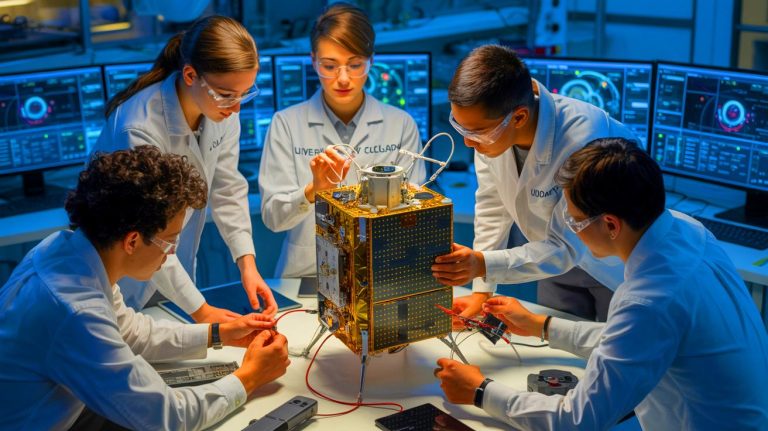| IN A NUTSHELL |
|
In an ambitious endeavor, a team of University of Calgary students is breaking new ground by launching the city’s first student-built satellite into space. The project, known as FrontierSat, aims to explore a little-understood atmospheric phenomenon. Spearheaded by undergraduates from the Schulich School of Engineering and the Faculty of Science, this initiative is not just about scientific discovery but also about providing students with invaluable hands-on experience. As Calgary is not traditionally known for aerospace, this project signifies a major leap in the city’s scientific and educational capabilities, potentially inspiring future generations of engineers and scientists.
Calgary’s First Student-Built Satellite
The FrontierSat project represents a significant milestone for the University of Calgary and its students. Led by CalgaryToSpace, a student group established in 2020, the project involves over 100 members who have collectively contributed to this pioneering mission. FrontierSat distinguishes itself from other Canadian student satellite projects by focusing on the upper atmosphere, an area rich with phenomena that remain largely unexplored.
The satellite is a CubeSat, a nanosatellite measuring about 12 inches in length, akin to the size of a loaf of bread. Equipped with a mini plasma imager and a deployable composite lattice boom, the CubeSat is prepared to investigate Strong Thermal Emission Velocity Enhancement (STEVE). STEVE is a rare, upper atmospheric light phenomenon, often compared to the aurora borealis for its visual spectacle, although it typically appears as narrow and purple.
By studying STEVE, the team hopes to unlock new insights into space weather and atmospheric behavior. Meagan Davies, a dual-degree student in astrophysics and biomedical engineering, emphasized the novelty of this research, noting that “STEVE hasn’t been studied much yet.” The satellite’s boom, while equipped with a camera for space imagery, primarily focuses on monitoring the spacecraft itself. These efforts underscore the team’s commitment to advancing scientific knowledge through innovative student-led research.
Built by Students
Funding for the FrontierSat project has been secured through a combination of sources, including the Canadian Space Agency’s national grant program, university programs, and student-led fundraising initiatives. The Canadian Space Agency recognizes the value of supporting such projects, both for advancing space research and for fostering interest in STEM careers among students.
Despite securing funding, the team encountered delays in finding a launch provider. Initially scheduled for a fall launch, the mission has been postponed to early 2026 due to overbooking. The CubeSat will be launched aboard a SpaceX Falcon 9 rocket, facilitated by the German-based company Exolaunch. These logistical challenges have tested the team’s resilience and adaptability.
Technical hurdles have also been a significant part of the journey. Combining the various components of the satellite and ensuring their seamless integration posed one of the largest challenges. Aarti Chandiramani, a geomatics engineering and aerospace student, highlighted the complexity of this task. The satellite has undergone rigorous testing, including a random vibration test in June designed to simulate the stresses of launch. Such meticulous preparation reflects the team’s dedication to ensuring the mission’s success.
A Learning Experience Like No Other
For many students involved, the FrontierSat project is a unique opportunity to gain practical experience in the field of aerospace. The project allows students to apply theoretical knowledge in a real-world context, enhancing their understanding and skills. This educational aspect is as crucial as the scientific objectives.
Participation in the project offers students the chance to work on a high-stakes, collaborative effort, mirroring the professional environments they may enter post-graduation. Working alongside peers from diverse disciplines fosters a spirit of cooperation and innovation, encouraging students to think creatively and solve problems effectively.
Johnathan Burchill, the principal investigator and an assistant professor, emphasized the enjoyment and educational value of the project, stating, “It’s fun, that’s the main thing. It’s a really fun project.” This sentiment underscores the importance of engaging students in hands-on projects that ignite passion and curiosity, preparing them for future careers.
The Future of Student-Led Space Exploration
As FrontierSat prepares for its launch, it stands as a testament to the potential of student-led initiatives in contributing to space exploration. The success of this project could pave the way for more student-driven research efforts, not just in Calgary, but across Canada and beyond. By demonstrating the capabilities and dedication of young scientists and engineers, FrontierSat may inspire new collaborations and projects in the realm of space research.
The project also highlights the importance of interdisciplinary collaboration and the role of educational institutions in fostering innovation. As more universities support similar initiatives, the boundaries of space exploration continue to expand, driven by the curiosity and ambition of the next generation.
The FrontierSat team’s journey is a reminder of the transformative power of education and research. It challenges us to consider how we can continue to support and nurture student-led projects that push the limits of what is possible in science and technology. What other unexplored frontiers might students venture into next, reshaping our understanding of the universe?
Did you like it? 4.4/5 (23)






Wow, Calgary’s getting into space! 🚀 What’s next, a lunar base? 😄
How did they manage to secure funding for such an ambitious project?
Can students from other universities join this amazing project?
Finally, a satellite that isn’t just about selfies! 😜
Will the data collected be available to the public or just the university?
This is truly inspiring! Kudos to the team for taking on such a challenging project. 👏
Why is STEVE’s light purple? Is it something atmospheric?